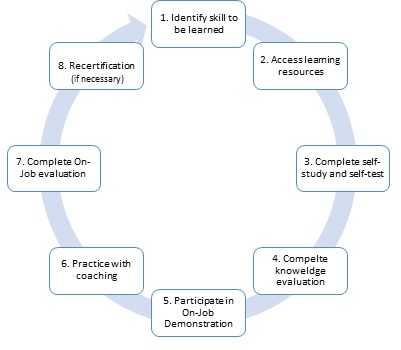Corporate Training: 3 Ways to Reinforce Skill Retention
Jill W.
There are many theories that describe how we learn skills. We can look to the literature on schema that suggests that when we learn a new behavior skill, a schema is created in our memory. This schema can then be retrieved in the future to guide our performance of that behavior (Gagne and Medsker, 1996).
We can also draw on more practical theories that talk about demonstration, practice, feedback and repetition. As a result of years of research in learning skills, we know that demonstration and practice are integral parts of learning (Kemerer, 1991). But learning a new skill is only one step in the learning process.
How do we ensure that new skills are retained and reinforced once learners return to their jobs? For training to be effective, the employee ultimately needs to apply what is learned on-the-job. If not, all of the time, money and effort spent on training is wasted.
This article is twofold. First, it briefly outlines an on-the-job learning cycle that can be applied in all industries. Second, it discusses three key elements for reinforcing skill retention: repetition, applicability and use of technology.
On-The-Job Learning Cycle
Step 1: Identify Skill to Be Learned
Training isn't necessary unless there is an identified need for training. Training becomes an intervention for performance improvement when there is a particular skill that an employee needs to acquire. This is step 1 of the learning cycle: Identify skill to be learned.
Step 2: Access Learning Resources
Next, learners need to have access to various learning resources. We know that people learn in different ways. Therefore, it's beneficial to have learning resources that address different learning styles. For example, online courses, manuals, reference guides, videos, skill checks, etc.
Step 3: Complete Self-Study and Self-Test
Self-tests are learning tools that enable learners to confirm their understanding of main learning points. Incorrect responses and their corresponding questions are identified to focus the learner's review efforts.
Step 4: Complete Knowledge Evaluation
The learning resources and self-tests help learners meet their learning objectives and prepare for step 4, the knowledge evaluation. An evaluation is designed to confirm mastery of the knowledge portion of the skill.
Step 5: Participate in On-Job Demonstration
Step 5 involves the on-job demonstration of the skill. This demonstration is completed by a designated coach using a target performance standard.
Step 6: Practice with Coaching
Next, the learner practices the skill. Practice is required to develop the learner's ability to perform the skill on-the-job and reinforce skill retention.
Step 7: Complete On-Job Evaluation
Once the learner feels confident in their ability to perform the skill, a practical evaluation will be completed by a competent team member or supervisor with direct reference to prescribed standards.
Just because the learner has successfully completed the practical evaluation doesn't mean that they will retain the skill if it's not something that is done on a daily basis. For training to be effective, learners should be able to transfer the skill to their everyday jobs. Having measures in place to reinforce what has been learned is necessary for skill retention.
Step 8: Recertification
The final step in the learning cycle is recertification. This doesn't apply to all industries, but learners, after a certain period of time, may be required to re-demonstrate their ability to perform the skill.
If recertification isn't something that is required in your industry, it doesn't hurt to re-evaluate your employees every once and a while, ensuring that they have the necessary competencies to be successful.

Source: Learning Cycle (Adapted from BaseCorp Learning Systems)
3 Key Elements for Reinforcing Skills Learned Through Training
Once a learner completes the full learning cycle, it's now time to reinforce those skills. Training is not a "once and done" instance. Reinforcement is key to keeping those skills top-of-mind.
There are three ways you can reinforce skills: repetition, applicability and effective use of technology.
1. Repetition
Repetition is a key principle of learning. It's also critical for skill retention. Think back to when you learned how to ride a bike or drive a car. First, you needed to learn the skill. Then it was about practicing and eventually, as you became more confident, riding the bike or driving the car became second nature. It was through repetition that these skills were reinforced. Think about the workplace - say you work as a salesperson for a clothing store. The first time you interacted with a customer, it probably didn't go well. After you went through training and practiced interacting with customers, you probably got a lot better at it. It was through repetition that you improved.
Repetition builds memory as well as confidence. This is the basis of a behavior or a task being 'second nature'. As employees complete their training and go back into the workplace, it is important to provide them with resources that will remind them of the nuances of their newly learned skill. Whether you verbally provide reinforcement, develop job aids or reference guides, every time an employee consults one of these resources, they are reminded of the skill. It helps them to successfully use the skill in their jobs. Remember, practice makes perfect.
2. Applicability
For training to be effective, the employee should be able to apply what is learned in the training to their everyday jobs. This is often referred to as transfer. Can learners "do it" in the real world? Adult learning principles suggest that if learners don't see the relevance of how learning a particular skill directly applies to their job, they are less likely to transfer and retain that skill. Adult learners need to be able to see the relevance of what they are learning. If the skill isn't applicable, the learner won't see the value in the training experience or in retaining the skill.
For more information on Malcolm Knowles' theory of andragogy (theory on how adults learn), visit infed.org.
3. Technology
If effectively used, technology is an excellent tool for reinforcing skills. After the training is over, there are many opportunities for you to help learners cement the learned material. Technology allows employees to learn from anywhere. Training reinforcement does not need to interrupt an employee's day or take them away from other work activities. Microlearning, or quick lessons designed to deliver content in bite-sized nuggets encourages employees to engage (see our blog post "10 Reasons to Adopt Microlearning in Your Online Training" for more information).
You will see organizations use gamification more often. According to Anthonie Wurth, founder of MindMarker, "when employees are motivated by their competitive drive to beat peers' performance in the game, and engage in the fun game environment, they are more likely to remember the learned material or skill". Post-training, you want to create opportunities for practice. When game-like features are combined with incentives and rewards to your post-training learning plans, learners are more likely to engage and retain the new skill.
Social learning (using forums and building communities of practice) allows employees to engage with their peers through interactive chats and online discussions. This is another strategy where technology can aid in skill retention. Social learning methods include online forums where learners can ask questions or public blog posts where staff can write and comment on particular topics and employers can respond. Forums also provide an arena where employers can quickly upload new or updated information.
Conclusion
There are three stages of training: before, during and after (see Karla Gutierrez's post). This article spoke in detail about the learning cycle, which occurs in the second stage of training, and focused on how skills are retained once the training has finished. Skill retention is important because it affects the performance of an employee on-the-job. By building strategies that include repetition, that are applicable and that effectively use technology, it's possible to effectively transfer skills learned in training to the workplace.
TopicsChoose Topic
📘 Ready to Elevate Your Learning Strategy?
Explore our comprehensive library of eBooks and tools on learning resource development, competency-based learning, and LMS implementation. Transform your training programs with insights from industry experts and practical templates.
Jill W.
Jill is an Instructional Designer at BaseCorp Learning Systems with more than 10 years of experience researching, writing and designing effective learning materials. She is fascinated by the English language and enjoys the challenge of adapting her work for different audiences. After work, Jill continues to leverage her professional experience as she works toward the development of a training program for her cats. So far, success has not been apparent.
